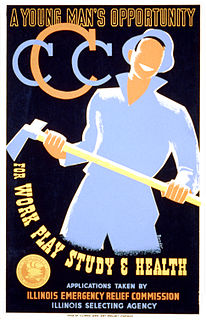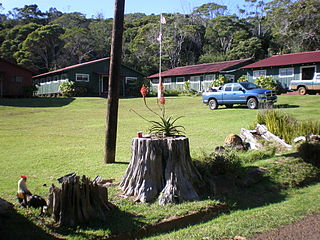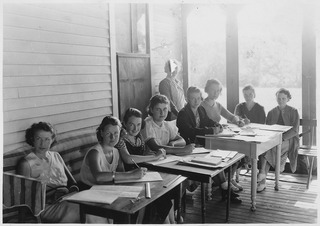 W
WThe Civilian Conservation Corps (CCC) was a voluntary public work relief program that operated from 1933 to 1942 in the United States for unemployed, unmarried men ages 18–25 and eventually expanded to ages 17–28. Robert Fechner was the first director of this agency, succeeded by James McEntee following Fechner's death. The CCC was a major part of President Franklin D. Roosevelt's New Deal that provided manual labor jobs related to the conservation and development of natural resources in rural lands owned by federal, state, and local governments. The CCC was designed to provide jobs for young men and to relieve families who had difficulty finding jobs during the Great Depression in the United States. Maximum enrollment at any one time was 300,000. Through the course of its nine years in operation, 3 million young men participated in the CCC, which provided them with shelter, clothing, and food, together with a wage of $30 per month.
 W
WDuring the Great Depression the Civilian Conservation Corps constructed a road to the ridge of Cheaha Mountain, the highest point in Alabama. The local name for the road is now official, the "CC Road" with one of the Cs of the Civilian Conservation Corps having been lost over the years in local usage. The Road contains ruins of stone arches and bridges in good condition. It has been closed for at least 18 years, and probably longer, by the National Forest Service. The lower end of the road is still open, and contains a few arches built during the Depression. The closed section of the CC Road is around a six-mile walk, although only a little over two miles of linear distance. A large native stone bridge in the closed section crosses Hillabee Creek, which provides drinking water to Oxford and Anniston.
 W
WIn 1932 one of every four American men aged 15–24 worked only part-time. The Civilian Conservation Corps (CCC) South Dakota was created to solve two of the nation's ills: unemployment and deteriorating national resources. In South Dakota the Civilian Conservation Corps (CCC) provided work for 23,709 enrollees and veterans, 4,554 Indians, and 2834 supervisory and office personnel. It distributed $6,200,000 in allotment checks to South Dakota families.
 W
WCivilian Conservation Corps Camp in Koke'e State Park is located at Hawaii Route 550, in Waimea, on the island of Kauai, in the U.S. state of Hawaii. It was built in 1935 with lumber that was put into the saltwater and floated to the shore at Port Allen, the seawater adding a natural termite protection to the lumber. The camp was in continual use for forest management, until Hurricane Iwa devastated it in 1982. In the 1990s it was restored through the efforts of the non-profit Hui O Laka environmental group, and is currently open to the public. It was added to the National Register of Historic Places listings in Hawaii on December 20, 1996.
 W
WThe Crater Historic District encompasses National Park Service structures within Haleakala National Park. The buildings include utility structures, employee housing, administration facilities and visitor services facilities. Most were built by the Civilian Conservation Corps to standard Park Service designs in the 1930s. A few World War II era buildings survive from U.S. Army construction, and are included in the historic district. The Crater Historic District was added to the National Register of Historic Places on November 1, 1974.
 W
WThe Hannah Robinson Tower is a 40 feet (12 m) tall wooden tower at the interchange between U.S. Route 1 and Route 138 in the community of South Kingstown, South County, Rhode Island. The tower was built in 1938 by the Civilian Conservation Corps and was rebuilt in 1988 using the same pillars. The structure is named after Hannah Robinson (1746–1773), a colonial Rhode Island resident and daughter of a wealthy Narragansett society man, Rowland Robinson. Hannah fell in love with a local teacher, Peter Simon, but the relationship was deemed unsuitable by her father. Despite her father's disapproval, Hannah Robinson married her suitor and lived in Providence, Rhode Island. The family became estranged from Robinson, who was enveloped in poverty, leading to a fatal decline. Robinson's father ended his opposition and left his community of Boston Neck to bring Hannah home. As Rowland Robinson brought his daughter home, she requested a chance to visit nearby McSparran Hill, where she considered a view of her homeland. Robinson died soon after.
 W
WPresque Isle International Airport, formally Northern Maine Regional Airport at Presque Isle, is a mile northwest of Presque Isle, in Aroostook County, Maine, United States. It serves the residents of Presque Isle and a vast area of northern Maine and northwestern New Brunswick. Airline flights to Newark Liberty International Airport are subsidized by the federal government's Essential Air Service program at a cost of $3,892,174.
 W
WThe She-She-She Camps were camps for unemployed women that were organized by Eleanor Roosevelt (ER) in the United States as a counterpart to the Civilian Conservation Corps (CCC) programs designed for unemployed men. ER found that the men-only focus of the CCC program left out young women who were willing to work in conservation and forestry and to sign up for the six-month programs living away from family and close support. She lobbied for a sister organization to the CCC that would be for young women. Eleanor Roosevelt proposed that this would consist of camps for jobless women and residential worker schools. The She-She-She camps were funded by presidential order in 1933. Labor Secretary Frances Perkins championed one such camp after ER held a White House Conference for Unemployed Women on April 30, 1934, and subsequently ER's concept of a nationwide jobless women's camp was achieved. While the public largely supported the New Deal programs and the CCC was a huge success, the women's version barely topped 5,000 women annually by 1936 and overall served 8,500 as a result of ER's support.
 W
WThe Tipsoo Lake Comfort Station was designed by the National Park Service Branch of Plans and Designs in the National Park Service Rustic style and built in Mount Rainier National Park by the Civilian Conservation Corps in 1934. The design was supervised by Park Service Chief Architect Thomas Chalmers Vint, and is similar to the Sunrise Comfort Station in the central portion of the park. Located near the park's northern entrance, two comfort station were planned to be part of a developed area in the vicinity of Tipsoo and Chinook Pass, which was never developed beyond the toilet facilities and an entrance arch. One of these survives and remains in use. The public toilet facility features rough stonework to window sill level, with a framed wall above and a log-framed roof with cedar shingles.
 W
WAlvin Cullum York, also known as Sergeant York, was one of the most decorated United States Army soldiers of World War I. He received the Medal of Honor for leading an attack on a German machine gun nest, taking at least one machine gun, killing at least 25 enemy soldiers and capturing 132. York's Medal of Honor action occurred during the United States-led portion of the Meuse-Argonne Offensive in France, which was intended to breach the Hindenburg line and force the Germans to surrender. He earned decorations from several allied countries during WWI, including France, Italy and Montenegro.